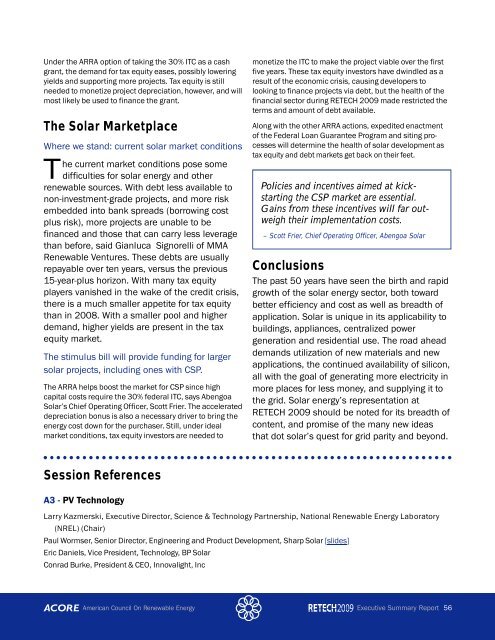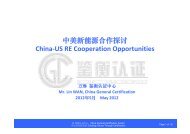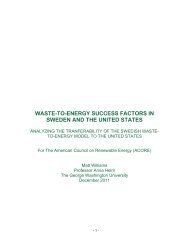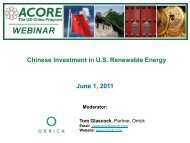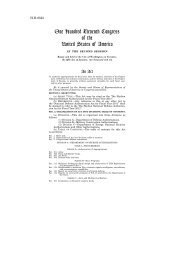Under the ARRA option of taking the 30% ITC as a cashgrant, the demand for tax equity eases, possibly loweringyields and supporting more projects. Tax equity is stillneeded to monetize project depreciation, however, and willmost likely be used to finance the grant.The Solar MarketplaceWhere we stand: current solar market conditionsThe current market conditions pose somedifficulties for solar energy and otherrenewable sources. With debt less available tonon-investment-grade projects, and more riskembedded into bank spreads (borrowing costplus risk), more projects are unable to befinanced and those that can carry less leveragethan before, said Gianluca Signorelli of MMA<strong>Renewable</strong> Ventures. These debts are usuallyrepayable over ten years, versus the previous15-year-plus horizon. With many tax equityplayers vanished in the wake of the credit crisis,there is a much smaller appetite for tax equitythan in 2008. With a smaller pool and higherdemand, higher yields are present in the taxequity market.The stimulus bill will provide funding for largersolar projects, including ones with CSP.The ARRA helps boost the market for CSP since highcapital costs require the 30% federal ITC, says AbengoaSolar’s Chief Operating Officer, Scott Frier. The accelerateddepreciation bonus is also a necessary driver to bring theenergy cost down for the purchaser. Still, under idealmarket conditions, tax equity investors are needed tomonetize the ITC to make the project viable over the firstfive years. These tax equity investors have dwindled as aresult of the economic crisis, causing developers tolooking to finance projects via debt, but the health of thefinancial sector during RETECH 2009 made restricted theterms and amount of debt available.Along with the other ARRA actions, expedited enactmentof the Federal Loan Guarantee Program and siting processeswill determine the health of solar development astax equity and debt markets get back on their feet.Policies and incentives aimed at kickstartingthe CSP market are essential.Gains from these incentives will far outweightheir implementation costs.– Scott Frier, Chief Operating Officer, Abengoa SolarConclusionsThe past 50 years have seen the birth and rapidgrowth of the solar energy sector, both towardbetter efficiency and cost as well as breadth ofapplication. Solar is unique in its applicability tobuildings, appliances, centralized powergeneration and residential use. The road aheaddemands utilization of new materials and newapplications, the continued availability of silicon,all with the goal of generating more electricity inmore places for less money, and supplying it tothe grid. Solar energy’s representation atRETECH 2009 should be noted for its breadth ofcontent, and promise of the many new ideasthat dot solar’s quest for grid parity and beyond.Session ReferencesA3 - PV TechnologyLarry Kazmerski, Executive Director, Science & Technology Partnership, National <strong>Renewable</strong> <strong>Energy</strong> Laboratory(NREL) (Chair)Paul Wormser, Senior Director, Engineering and Product Development, Sharp Solar [slides]Eric Daniels, Vice President, Technology, BP SolarConrad Burke, President & CEO, Innovalight, Inc<strong>American</strong> <strong>Council</strong> <strong>On</strong> <strong>Renewable</strong> <strong>Energy</strong>Executive Summary Report 56
Haroula Reitz, Global Manager of Science and Technology, Dow Corning Solar SolutionsChris Shirk, Solar Module Assembly Science and Technology Manager, Dow Corning Solar Solutions [slides]A4 - PV Economics, Finance & PolicyChristopher O’Brien, Head of Market Development, North America, Oerlikon Solar (Chair) [slides]Steve Chadima, Vice President, External Affairs, Suntech America [slides]Adam Browning, Executive Director, Vote Solar Initiative [slides]Gianluca Signorelli, Director, MMA <strong>Renewable</strong> Ventures [slides]A5 - PV Markets & SystemsTravis Bradford, President, Prometheus Institute (Chair) [slides]Paul McMillan, Principal, Utility Group, SunPower [slides]Thomas Sauer, CEO, EXXERGYBryan Ashley, Vice President of Marketing and Sales, Suniva [slides]David Arfin, Vice President, Customer Finance, Solar City [slides]Richard Raeke, Director of Project Finance, Borrego Solar [slides]A6 - CSP Technology & CostScott Frier, Chief Operating Officer, Abengoa Solar (Chair) [slides]Charlie Ricker, Senior Vice President, Marketing & Business Development, BrightSource <strong>Energy</strong> [slides]Avi Brenmiller, President, SolelRainer Aringhoff, President, Solar Millenium LLC [slides]Arnold Leitner, CEO and President, SkyFuel [slides]A7 - CSP ProjectsRob Church, Vice President, Industry Research and Analysis, <strong>American</strong> <strong>Council</strong> <strong>On</strong> <strong>Renewable</strong> <strong>Energy</strong> (ACORE) (Chair)Craig Tyner, Senior Vice President, Engineering, eSolar [slides]Erik Ellis, Vice President for Projects, Ausra [slides]Scott Frier, Chief Operating Officer, US Operations, Abengoa Solar [slides]Sean Gallagher, Vice President, Market Strategy & Regulatory Affairs, Striling <strong>Energy</strong> Systems [slides]F5 - Feed-In TariffsLois Barber, Executive Director, EarthAction, Co-Chair, Alliance for <strong>Renewable</strong> <strong>Energy</strong> (Chair)R. James Woolsey, Venture Partner, Vantage PointWilson Rickerson, Principal, Rickerson <strong>Energy</strong> Strategies [slides]John Burges, Managing Director, Knight Capital Markets [slides]Murray Cameron, Chief Operating Officer, Phoenix Solar [slides]Cheri Olf, Director of Education and International Workforce, <strong>American</strong> <strong>Council</strong> <strong>On</strong> <strong>Renewable</strong> <strong>Energy</strong> (ACORE)Steve Lapp, Engineer, <strong>On</strong>tario Green <strong>Energy</strong> Act Alliance [slides]<strong>American</strong> <strong>Council</strong> <strong>On</strong> <strong>Renewable</strong> <strong>Energy</strong>Executive Summary Report 57
- Page 6:
The highlights of WIREC 2008 includ
- Page 9 and 10:
EVENT SPONSORSHosted byBadge Sponso
- Page 11 and 12:
EXHIBITORS ContinuedKamatics Corp.K
- Page 13 and 14:
The ARRA contains the following ite
- Page 15 and 16:
“How do we organize ourselves to
- Page 17 and 18: John GeesmanFormer Commissioner, Ca
- Page 19 and 20: Cathy ZoiCEO, Alliance for Climate
- Page 21 and 22: John CavalierManaging Partner, Huds
- Page 23 and 24: BiofuelsChristopher Groobey, Partne
- Page 25 and 26: Patrick Cloney, Executive Director,
- Page 27 and 28: Gal Luft, Executive Director, Insti
- Page 29 and 30: Daniel Kammen, Class of 1935 Distin
- Page 31 and 32: Biomass, Biofuels, and Advanced Veh
- Page 33 and 34: Critical development opportunities
- Page 35 and 36: ConclusionsSpeakers at RETECH 2009
- Page 37 and 38: Geothermal PowerOverviewThe United
- Page 39 and 40: Green Buildings and CommunitiesOver
- Page 41 and 42: Green construction and renovation s
- Page 43 and 44: Session ReferencesGreen Schools Bre
- Page 45 and 46: 1. The local electric power market
- Page 47 and 48: International Renewable Energy Indu
- Page 49 and 50: production was 37%; the domestic tu
- Page 51 and 52: There have been a number of incenti
- Page 53 and 54: educes mortality and improves gende
- Page 55 and 56: D7 - ChinaJing Su, Director of US-C
- Page 57 and 58: past, uncertain legislative environ
- Page 59 and 60: marketplace, accelerating and deepe
- Page 61 and 62: • Complexity and operating costs
- Page 63 and 64: C6 - Environmental and Carbon Finan
- Page 65 and 66: The technology debate: thin film ve
- Page 67: FITs have grown in popularity over
- Page 71 and 72: Currently, planning is geographical
- Page 73 and 74: Federal policy should allow for a c
- Page 75 and 76: Wind: Markets, Technologies, and Po
- Page 77 and 78: Regional FactorsBesides federal pol


